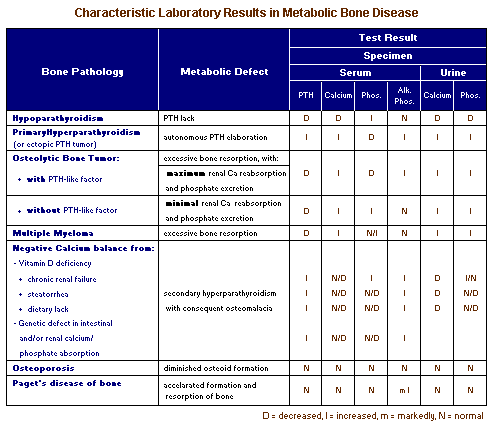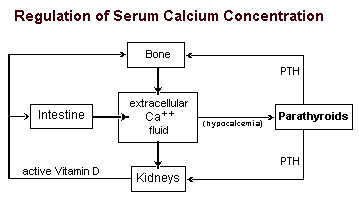- reabsorption of calcium is increased so that a minimum of about 0.1-0.5% of filtered calcium is excreted (compared to 1-5% with basal PTH concentrations);
- phosphate reabsorption is decreased to a minimum of about 30% of that filtered compared to the usual 80-90% reabsorption of filtered phosphate;
- active vitamin D is elaborated.
Hypercalcemia inhibits PTH elaboration. The negative feedback effect maintains serum calcium concentration within the normal range.
Secondary hyperparathyroidism is an appropriate compensatory response, to a negative calcium balance, the intent of which is to maintain normal circulating calcium concentrations, though, at the expense of bone resorption and consequent osteomalacia.
Dysfunctional Calcium Homeostasis
| Relationship between Ca and PTH |

- Conditions associated with a negative calcium balance and consequent secondary hyperparathyroidism include:
- Chronic renal failure (most common)
- Vitamin D deficiency
- phosphate retention and loss of Ca++ from metastatic calcification
- Vitamin D deficiency from other causes:
- Intestinal malabsorption
- Dietary deficiency
- Congenital defects in renal tubule and/or intestinal absorption of calcium and/or phosphate.
- Chronic renal failure (most common)
- Hypoparathyroidism results in decreased plasma calcium concentration because of decreased intestinal and renal tubular calcium absorption and lack of bone resorption with consequent dense bone.
- Hypercalcemia may result from:
- excess calcium intake
- milk alkali syndrome
- vitamin D intoxication
- autonomous elaboration of PTH from:
- primary hyperparathyroidism
- ectopic hormone elaboration (a PTH-like protein may be elaborated rather than PTH)
- osteolytic bone tumors (with or without involvement of a PTH-like protein) :
- primary osteolytic bone tumors (e.g. multiple myeloma)
- osteolytic metastases
- sarcoidosis
- excess calcium intake
Return to the Table of Contents
Pertinent Laboratory Tests
(Click on a test for details.)
Test Normal Range
calcium, total serum 8.5 - 10.8 mg/dl
free, ionized 1.0 - 1.3 mM
urine 5 - 40 mg/day (Ca free diet)
100 - 300 mg/day (average diet)
phosphate, serum 3.0 - 4.5 mg/dl
urine 0.4 - 1.5 g/day
alkaline phosphatase 50 - 125 munits/ml
Parathyroid hormone
serum Cl-/phosphate ratio 17 - 33
% tubular reabsorption
of phosphate 78 - 91
urine cyclic AMP 2 - 4.3 nmole/100ml GFR
______________________________
Characteristic laboratory test results in metabolic bone disease are summarized in the table below.

Hypoparathyroidism most commonly occurs iatrogenicially because of overaggressive surgical treatment of hyperthyroidism. With PTH lack, there is inadequate intestinal absorption of calcium, and possibly phosphate, minimal resorption of bone salts (with
consequent increased bone density), and maximum renal phosphate reabsorption. The net effect is hypocalcemia and hyperphosphatemia. Though renal calcium reabsorption is minimal, urine calcium excretion is not increased because serum calcium concentration is depressed.
In inappropriately elevated parathyroid hormone (from primary hyperparathyroidism or from ectopic tumor), intestinal absorption of calcium and phosphate is maximum, bone resorption is overstimulated as is osteoblastic activity (causing increased serum alkaline phosphatase activity), renal reabsorption of calcium is maximum and of phosphate is minimal. The classical bone lesions of long standing primary hyperparathyroidism are referred to as osteitis fibrosa cystica or von Recklinghausen's disease. When primary hyperparathyroidism is diagnosed early, the bone lesion is usually a mild form of osteomalacia.
Characteristic laboratory findings include hypercalcemia, hypophosphatemia, elevated alkaline phosphatase, hypercalcuria and hyperphosphaturia. Hypercalcuria is found even though renal calcium reabsorption is maximum because the renal threshold for calcium reabsorption is exceeded. The finding of low serum PTH and elevated urine cyclic AMP is strong evidence for ectopic elaboration of a PTH-like factor.
Osteolytic bone tumors cause the release of excessive amounts of calcium and phosphate from bone. The parathyroid glands are thus inhibited so that renal calcium reabsorption is minimal and phosphate reabsorption is maximum. Hypercalcemia and hyperphosphatemia are characteristic findings along with hypercalcuria and hyperphosphaturia. Serum alkaline phosphatase activity is typically normal because of a lack of osteoblast stimulation. In some cases, hypophosphatemia and elevated alkaline phosphatase are found, because of elaboration of a "PTH like factor".
Secondary hyperparathyroidism results from a negative calcium balance; osteomalacia is a consequence. The most common cause is
chronic renal disease because of active vitamin D deficiency and hyperphosphatemia. Other causes of vitamin D deficiency include
dietary lack, fat malabsorption and congenital defects in Ca and/or phosphate absorption. Serum calcium concentrations, as well as phosphate, are often maintained within the normal range. Alkaline phosphatase is elevated because of compensatory stimulation of osteoblastic activity. Osteoblasts synthesize sufficient osteoid, but mineralization is deficient because of the negative calcium balance.
Osteoporosis is caused by many of the same conditions that cause
osteomalacia. However, osteoblastic synthesis of osteoid is
depressed so that unmineralized osteoid is not present in excess
as it is in osteomalacia. Alkaline phosphatase activity is not
elevated because osteoblastic activity is diminished.
Paget's disease of bone (osteitis deformans) is caused by accelerated resorption and formation of new bone. The two opposing processes are well balanced so that serum calcium and phosphate concentrations are normal. Alkaline phosphatase activity is dramatically increased corresponding to increased osteoblastic activity.
Return to the Table of Contents
Reviewed: April 3, 2000
